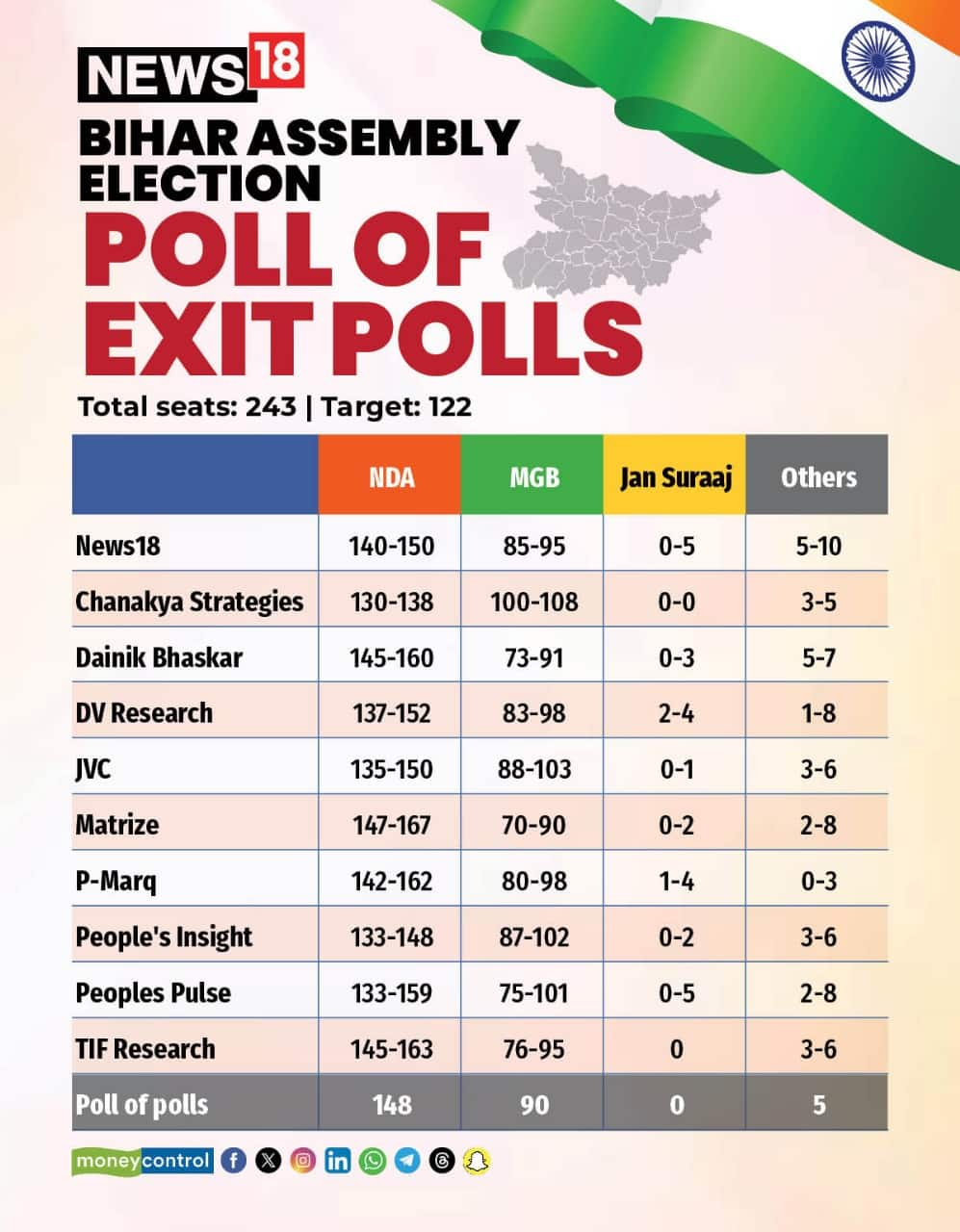



Although the Bharatiya Janata Party (BJP) contested the same number of seats as the Janata Dal (United) in the Bihar Assembly polls, it may not yet assume the role of the dominant partner in the alliance. According to the News18 Mega Exit Poll, the JD(U) is poised to emerge as the single largest party with 60-70 seats -- a notable jump from its 2020 tally of 43 seats.
Meanwhile, in the Mahagathbandhan camp, the Rashtriya Janata Dal (RJD) is expected to win 50-60 seats, a sharp decline from 75 seats that in won in the previous polls. The Congress is expected to go home with 15-20 seats.
Notably, this was the first time that chief minister Nitish Kumar’s JD(U) agreed to contest the same number of seats as BJP -- veering from the “big brother, small brother” in the relationship. Previously, the saffron party contested fewer seats that JD(U) when they fought under the the National Democratic Alliance (NDA).
NDA on course for comfortable victory
The News18 Mega Exit Poll projections show that the NDA is expected to secure 140 and 150 seats in the 243-member Bihar Assembly – well above the halfway mark of 122.
The JD(U) is expected to become the single largest party with an estimated 60-70 seats, marking a significant jump from the 43 it secured in the previous Assembly elections -- reflecting a stronger consolidation of NDA’s vote base and a recovery from the setbacks caused in 2020 polls by the Lok Janshakti Party (LJP)’s independent run.
The saffron party, which contested on 101 seats (compared to 110 in 2020) is expected to bag 55 to 65 seats – a slight decline from its 2020 tally of 74 seats.
Despite lingering scepticism around his health, Nitish Kumar continues to command significant political influence in Bihar, particularly as the BJP lacks a strong local leader to project in place of its reliance on Prime Minister Narendra Modi.
Although the JD(U) and BJP contested an equal number of seats, prompting expectations that Kumar might slip into a junior role, current projections underscore sustained public confidence in his two-decade-long leadership.

What could have worked well for NDA?
-The fractures that marked the 2020 election -- notably the undivided LJP’s undercutting of the JD(U), costing it an estimated 10–15 seats -- were absent in 2025.
-With an equitable seat-sharing formula of 101 each for the BJP and JD(U), 29 for the LJP-RV, and limited space for minor partners, the alliance avoided internal competition and regained lost support, particularly in EBC and OBC belts.
-Welfare programmes such as the Rs 10,000 transfer under the Mukhyamantri Mahila Rojgar Yojana, promise of 1 crore government jobs and employment opportunities and mission to create 1 crore “Lakhpati didis” are expected to have resonated well with women voters -- who turned up in large numbers to vote in Bihar.
-The BJP’s urban and upper-caste mobilisation, reinforced by cultural themes like the Ram Temple could have complemented JD(U)’s rural EBC/Kurmi anchoring.
However, exit polls do not always hold true as was witnessed in the previous Assembly election when most of them had predicted a win for Mahagathbandhan. Tejashwi Yadav’s RJD emerged as the single largest party with 75 seats, while the BJP followed closely with 74. Altogether, the NDA secured 125 seats while the grand alliance bagged 110 seats.
Discover the latest Business News, Sensex, and Nifty updates. Obtain Personal Finance insights, tax queries, and expert opinions on Moneycontrol or download the Moneycontrol App to stay updated!